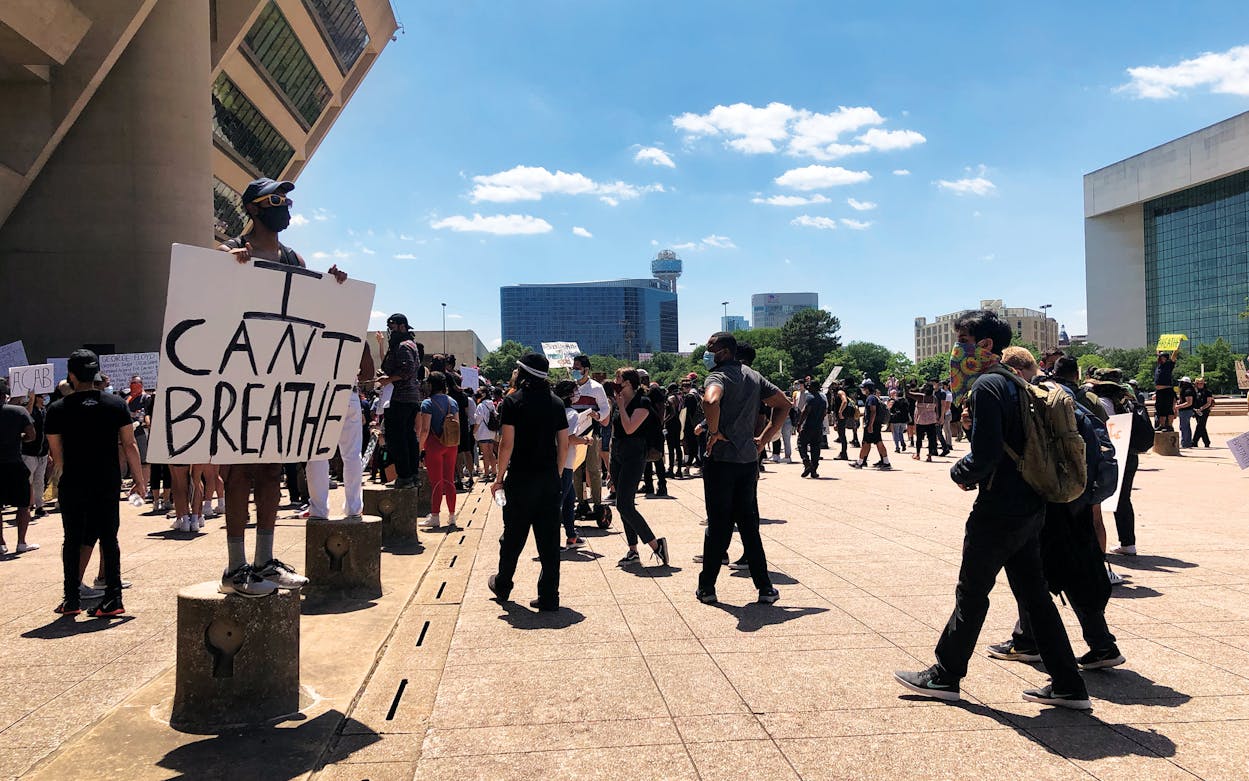The armored SWAT vehicles arrived at Dallas City Hall shortly after 4 p.m. on Saturday, along with officers carrying thick shields and guns. Protesters, about a thousand feet away from the city’s Confederate War Memorial, had just shattered the windows of at least two police cruisers, causing the vehicles to retreat. As the newly arrived cops pointed their weapons at demonstrators, the protesters chanted, “Hands up, don’t shoot.” The police began to forcibly disperse the crowd, first with what appeared to be concussion grenades, then with tear gas. Some protesters were hit with tear gas canisters and pepper-spray projectiles; screaming from the pain, they ran to get aid and douse their eyes.
Similar scenes played out in Dallas across a tumultuous weekend. Beginning Friday night, thousands took to the streets, joining in nationwide protests in response to the police killings of Breonna Taylor in Louisville and George Floyd in Minneapolis. But Dallas demonstrators also were brought out to protest by multiple recent police killings in the Metroplex. In September 2018, off-duty Dallas police officer Amber Guyger entered the apartment of Botham Jean, later saying she thought it was her own, and murdered him. In October 2019, Fort Worth officer Aaron Dean followed a 911 call to Atatiana Jefferson’s house and shot her through a window as she was playing video games with her nephew.
Beginning Friday night, demonstrators, some of whom vandalized police vehicles, were met by Dallas officers in riot gear who used tear gas on crowds, reportedly for the first time in decades. There have been a number of recent high-profile incidents involving the police force in Dallas, including the killing of five police officers in 2016. But Mayor Eric Johnson said in a press conference Saturday that he has never seen anything like this in the city. “We are going through a tremendous struggle in this city, the most significant struggle I have ever seen in my lifetime,” he said.
Many demonstrators said frustrations with police had boiled over. “I’m a mother. I was born in the late fifties, so I remember a time like this, and I can’t believe this is still going on years later,” said Sandra Leonard, a Dallas resident who joined the protests. “It’s sixty years later! It is time for a change.”
On Friday night, some demonstrators in downtown Dallas vandalized police vehicles and storefronts and were dispersed by police using tear gas.
Protesters came back to Dallas City Hall on Saturday. They marched through the downtown historic district, chanting, “Say his name, George Floyd, say her name, Breonna Taylor,” “No justice, no peace, f— these racist-ass police,” and “I can’t breathe.”
At around 4 p.m., a line of police cruisers and officers with shields faced the ire of an angry crowd in front of city hall. The armored vehicles arrived, and police began to disperse crowds. By 5 p.m., police began to barricade and block roads and, with tear gas and pepper balls, pushed protesters farther away from city hall.
Although many demonstrators left the protest, hundreds stayed and continued to march into the night. “We stay because our voices need to be heard,” said a fourteen-year-old, who attended the protest with his younger brother. “What they’re doing to us is not right. What they’re doing to everyone is not right. I’m pissed. Everything is just f—ed up.”
As the sun began to set, the protests took a more dangerous turn. Dallas officers used police cars and trucks to block off streets into downtown, and even some highway exits, to prevent more protesters from coming in. The crowd dwindled to about two hundred protesters.
Once the Dallas demonstrators were corralled inside a few blocks, police deployed tear gas canisters, fogging an entire block near Elm Street. With the air unbreathable, officers announced that demonstrators would be arrested if they didn’t leave.
The police ended up arresting nearly ninety protesters Saturday, according to a report from the Dallas Morning News.
Protests resumed Sunday. Demonstrators held a vigil for George Floyd at Freedman’s Cemetery, a burial ground established in 1861 for Dallas’s African American community. In the early afternoon, Governor Greg Abbott declared a statewide disaster, allowing him to deploy federal law enforcement officers as peace officers in the state. Dallas police chief Reneé Hall announced a 7 p.m. curfew for the city’s downtown, Deep Ellum, Uptown, and Victory Park neighborhoods.
As the curfew approached, about 500 protesters marched in Deep Ellum, flanked by police vehicles. After issuing a warning, police used tear gas and pepper-spray projectiles to disperse crowds. They arrested at least 76 more on Sunday night.
Dallas protester Caitlin Banks said she expects demonstrations to continue until the city takes action to reform its policing.
“How can they expect peace when they won’t give us peace?” she asked. “They can’t expect things from us if they won’t give it to us.”
- More About:
- George Floyd
- Dallas






